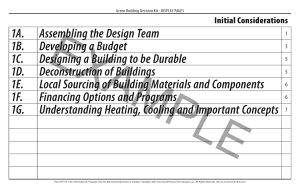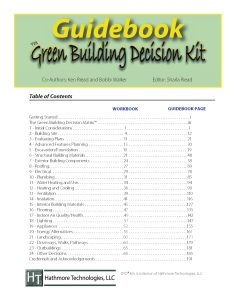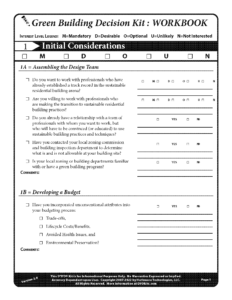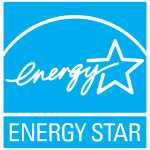Initial Considerations:
As you consider using a Design Charrette for your residential or small commercial project1 you may be wondering how to start. Your initial considerations should include:
- Who to invite for your design team
- What is your budget for the project
- How will it be financed
- What type and amount of materials you want use in your project
- Where those materials come from
Assembling the Design Team may seem obvious at first but might prove challenging as your project requirements evolve. What resources should you use to locate a suitable architect for your residential or small commercial1 project or how do you find a competent facilitator for your design charrette sessions?

What to do if your goal is to build a certified green or ENERGY STAR2 home that qualifies for government energy tax incentives and/or utility rebates? Who should you have on your team to get the best start possible for your project?
Inside the Green Building Decision Kit (GDBKit) Guidebook you will find a list of potential team members plus questions for you to consider as you build your team. There are suggestions about organizational affiliations that could provide additional information as well.
At a minimum you will likely need to include for your project is a designer or architect and/or engineer, the general contractor or builder, and a certified home energy rater, aka: HERS Rater3. Why do you need a HERS Rater? If you want to get residential tax credits and incentives, plus available rebates for your larger purchases like a heating and cooling system or induction stove you will need to involve a rater at the beginning of your project.
More information about home energy raters will be covered in later pages on this website and also in the GBDKit. Use the button below to purchase the kit for only $5.
Developing a Budget often proves vexing for many projects because of all the variables that can be involved, including interest rates, lender requirements, latest building and energy codes, zoning rules, and more. Many of these variables are addressed in the GBDKit Guidebook and companion WORKBOOK to help refine your budget.
We suggest that you start with an estimated initial budget knowing that it will probably change several times as you learn more about your options during the course of your Design Charrette.
You should have your home energy rater perform several energy models to compare and include all the tax credits, rebates and incentives that are available for your project.

Designing a Building to be Durable: Media headlines are filled with stories about wildfires, floods, hurricanes, tornadoes, and other disasters.
Designing a building to be durable also means making the building resilient to extreme events. Ways to do this are covered in the GBDKit.
Deconstruction of Buildings: Some building materials create environmental hazards or will take thousands of years to degrade/decompose. Many architects, engineers, and designers are focusing on building materials that create minimal pollution and can be either reused, recycled, or will decompose over time. Natural materials such as stone or wood can be substituted for energy-intensive products like steel or concrete.
Local Sourcing of Building Materials and Components: Shipping materials over long distances is very energy intensive. Inlaid marble tile that comes from a foreign source can often be substituted with marble produced domestically or even replaced by wood floors or ceramic tiles. The closer a product is to your building site the less energy it takes to transport it. Very often a local cabinet maker produces a product that is similar to or even better than cabinets from a distant factory.
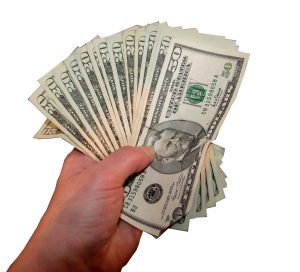 Financing Options and Programs: Many people have never heard of an energy mortgage and yet they have been available for decades. There are many benefits that an energy mortgage provides over a conventional or federal mortgage. In fact, secondary mortgage markets like FHA/HUD, VA, Fannie Mae, and Freddie Mac have their own version of energy mortgages.
Financing Options and Programs: Many people have never heard of an energy mortgage and yet they have been available for decades. There are many benefits that an energy mortgage provides over a conventional or federal mortgage. In fact, secondary mortgage markets like FHA/HUD, VA, Fannie Mae, and Freddie Mac have their own version of energy mortgages.
To learn more about specific energy mortgage programs you can open your browser and type a question like: “FHA energy mortgage” and you will get details. There are other financing programs available for financing energy and green upgrades including Property Assessed Clean Energy or PACE programs. Additional details about these programs and more are included in the GBDKit Guidebook and Workbook.
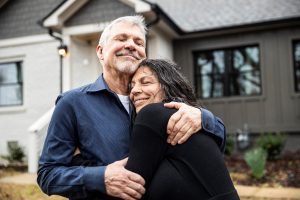
Your project is unique to you, and the GBDKit is designed to help you with all your project considerations with a focus on your specific project. This is why it is important to work through the entire kit and develop answers to the multitude of questions and decisions that help achieve the desired outcome for your project.
1. The GBDKit will prove helpful for the design and construction of a small commercial building, provided that the building uses residential equipment and construction techniques/products. The kit does not cover commercial HVAC equipment such as chillers, roof top units
2. ENERGY STAR Homes Program: Some residential energy tax credits and rebates require certification in specific programs in order to receive the money or other incentives. Depending on your location there may be incentives available to build a certified green home. More information about these programs can be found inside the GBDKit.

